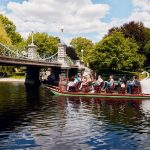2023 New England Fall Foliage Update | Get Ready for a Long Season of Color!
Want the latest and greatest 2023 fall foliage predictions? We caught up with Yankee foliage expert Jim Salge for the updated scoop.

Coffee By Design | Portland, Maine
Photo Credit : Katherine KeenanThe big fall show in New England is fast approaching, with just a few weeks until the earliest peak colors explode upon the hills up north. But with the continued heat, humidity, and rain, it’s time to look again at our predictions for this fall. In this update to our first 2023 foliage forecast with Yankee foliage expert Jim Salge, we find out how the season is progressing — and what we can really expect for this year’s color.
2023 New England Fall Foliage Update | Q&A with Expert Jim Salge
With the color kickoff almost upon us, what word do you find yourself using most often to describe this year’s New England fall foliage forecast?
It’s always amazing the reach that our fall foliage forecast has here at Yankee. I’ve had interviews with so many outlets since mid-August, and the words that keep coming up are pastel and pendulum.
“Pastel” comes up when talking about the expected quality of the colors. While a flip to cool, clear weather would certainly help, it is becoming increasingly likely that this will not be the best year for bold, bright red colors in our forested landscape. A more muted palate is expected, but the trade-off is that it should be long-lasting. “Pendulum” helps explain why. Two years ago we had a wet, humid summer. Last year was an extreme drought. And this year, it’s back to warm and wet.
Average conditions bring about our boldest fall colors, so we really need this pendulum to stop swinging so widely.
Your initial forecast predicted that we’ll see a lot of early color in 2023. How’s that looking?
We’re already seeing it, from northern Maine down to Rhode Island. A lot of the color is swamp maples, which turn as early as mid-August in the wettest years. But there are also stressed trees on some hillsides from all the rain this summer. Most of the forest is still green, but these early patches sure do catch the eye!
You also thought we’d reach peak a bit later than normal, but that it would last longer. Has this forecast changed?
It hasn’t, and it’s only become more clear that the foliage is going to peak a bit late this year. We are only a week or so away from the earliest traditional peak times in the far north and mountains, but it’s been so warm, cloudy, and humid, that it definitely won’t happen on the normal schedule.
With all the moisture, though, there will be little impetus for the leaves to drop quickly after peak, so it should be a long season. Especially combined with the early color we are already seeing.


Photo Credit : Jim Salge
Peak color in New England typically moves in a north-south wave from late September through late October. Will that timeline hold true this year?
With the later-than-average peak times expected up north, this is the type of season where, if a good clearing cold front comes through in October, a lot of the region could turn at once. Yes, generally from north to south, and elevation to coastline, but compressed significantly if we see a punch of cold air. Absent that, I think the whole season will just run a week or so late.
We have a Peak New England Foliage Map to help in your planning, and each week we’ll be highlighting where the foliage is turning across the region in our “Where to See Fall Foliage This Weekend” planner.
You had some lingering questions in your first forecast, and one of them was leaf fungus. Are we seeing this? How will it affect our fall colors?
Unfortunately, yes. With so much moisture, humidity, and general dampness this summer, which has continued into the early fall season, a few different foliar fungi have set up, especially on maples. The most common are anthracnose and septoria leaf spot, both of which brown the leaves.
For a number of reasons, the old stately sugar maples along roadways seem to be most affected, with the interior forests less so. Unfortunately, these are the trees that a lot of leaf-peepers love most. They will likely have some browning and early leaf drop this year.
Interestingly, there are a couple of other reasons why the forests have a hint of brown when looking at them from a distance. Both sugar maples and white pine have very heavy crops of seeds this year, and the cones and seeds are covering many treetops, looking brown from afar.

Photo Credit : Jim Salge
Where in New England will the color really wow?
Downeast and coastal Maine seem to have the best setup this year, having been spared the worst of the summer rains. I also called for southern New England to have a nice year if we get some good pushes of cooler air in October, and I still hope this to be true.
I really want to highlight Vermont, though. Vermont has some of the best forests for fall color in the world and really suffered with the flooding this year. Even if the colors aren’t exceptional, they are always beautiful, and I encourage you to direct your leaf-peeping adventures towards the hard-hit Vermont communities.
With that, are there any drives that should be especially nice this year?
The Acadia Loop Road and the Camden Hills in Maine are going to be great drives in mid-October this year. Earlier than that, Grafton Notch in Maine should be beautiful. But we hope that people explore the length of Route 100 in Vermont too! I’d also think that some of the drives in Connecticut’s quiet Northeast Corner and Rhode Island could have nice color and weather late into October.
Finally, what’s on your list for fun this foliage season?
I have never shown my daughters the magical world above the trees on Mount Washington in the fall, and I am looking forward to a drive up the Mount Washington Auto Road in a week or so. The landscape is a fragile, ecological treasure that I simply love and can’t wait for them to see. Later in the season, I hope to explore the Monadnock-Sunapee Greenway Trail, as I spent a day in the area last year and it wasn’t enough! And of course, cider donuts, apple crisp, and fair food are annual cravings that I will not pass up!








We’re on vacation the 2nd week of October in the Berkshires looking forward to some magnificent views from Jiminy Peak and Vacation Village riding up the ski lift and driving through the Mts. going for a ride to the top of Mt. Greylock.